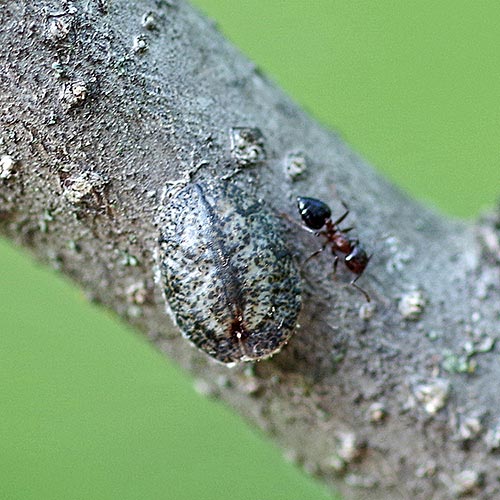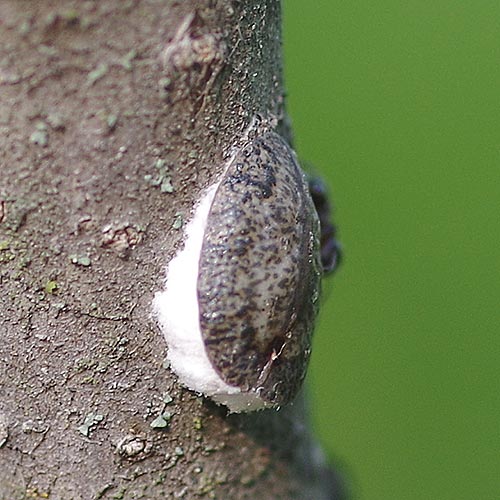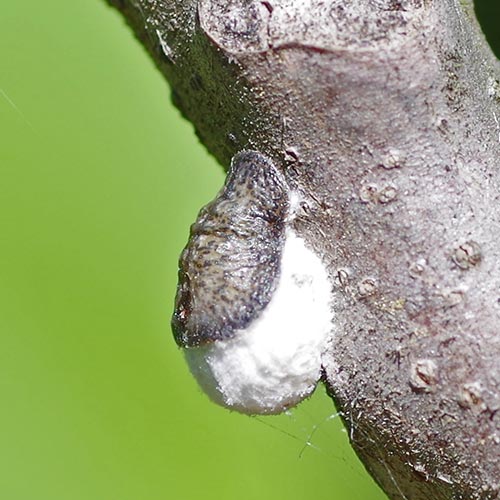Salutations, BugFans,
A few years ago, the BugLady spotted an unusually cooperative Kennedy’s Emerald dragonfly hanging from a walnut twig, and since then, her eyes scan the edges of that tree every time she passes it, hoping that lightning will strike twice. One day in June, she found this scale insect there, with a few attendant ants.
In the course of her research, she came across an entry about scale insects in the Blue Bay Barrens blog, in which the author, Steve Willson, writes “If I’m just out looking around, I never fail to investigate anything that draws the attention of the Allegheny Mound Ants. If the ants are involved, there is undoubtedly something of interest to be seen.” The BugLady’s sentiments, exactly. More in a sec about the ants’ affiliation with this Bug-on-the-half-shell.
Cottony Maple Scale
The BugLady is not sure of who this scale is. It looks like a Cottony Maple Scale (Pulvinaria innumerabilis) (the BugLady loves that species name), or something closely related to it. Despite its name, the Cottony maple scale is found on quite a list of woody plants, from forest trees to fruit trees to shrubs to grapevines (full disclosure: she didn’t find walnut on any of those lists of host plants, but at least 47 species have been documented). The life histories of the Pulvinaria (Cottony Scales) are pretty similar, so we’ll use this as the Posterscale for the group. Cottony Scales are in the family Coccidae; in older insect guides they are listed in the order Homoptera, but that order has been folded into the suborder Sternorrhyncha within the order Hemiptera (True Bugs). Scales are a big group, and they come in lots of different sizes and shapes and lifestyles.
What are we looking at here? The gray-brown, tortoise-y-looking shell is the exoskeleton of the female, and it’s covered with wax. Scales have pretty extreme sexual dimorphism (two forms). Females spend their adult lives fixed in one spot, under that shell sometimes antennae-less, sometimes legless. Males, which are described as looking vaguely gnat-like, are mobile and may or may not have wings as adults. The nymphs, at about ¼” long, pale, and covered with waxy filaments (kind of like a wooly aphid or a walking scale egg sac), are twice the size of their mother; female nymphs are wingless.
Scale insects have quite an on-line presence, and, due to their diet, it’s not an entirely neutral one (many of the hits are for Cottony Cushion Scale, a distantly related pest of citrus trees). Nymphs and adult female Pulvinaria scales pierce plant stems/twigs and drink plant juices in search of amino acids (males have no mouthparts and are very short-lived). In small numbers, they do little damage to the tree—mostly survivable and temporarily cosmetic. During periodic population booms, which may last two or three years until their predators catch up, they can cause leaf-drop or twig death, or they can sap the energy of plants, leaving them vulnerable to disease.
Amino acid concentrations are low, so scales (and aphids and other sap-feeders) process sap and excrete excess sugar water as a substance called honeydew. Honeydew lands on leaves, cars, patios, etc. rendering them a bit “tacky,” and attracting a variety of insects that feed on it. In exchange for honeydew, ants are in attendance to protect the scales from predators like mites, parasitic flies and wasps, and ladybugs (whose larvae may reside in masses of tiny scale nymphs). If honeydew accumulates on leaves, it acts as a culture medium for sooty mold, which looks just like it sounds and which blocks sunlight to leaves.
In the “Fifth Report of the United States Entomological Commission, Insects Injurious to Forest and Shade Trees” (1890), Alpheus S. Packard tells us that “This insect has not been troublesome in this part of Missouri since 1884; but in and around Rockford, Ill., I learned that it had been so abundant on the soft maples for three successive seasons as to kill many young trees outright and greatly injure the older ones. I was told that the side-walks shaded by these trees became so defiled and slippery from the exudations of the scale insect that it was difficult and unpleasant to walk on them. The citizens had consequently conceived a prejudice against the soft maple, and many were being cut down or dug up and replaced by other trees.”
The only/most conspicuous stage is the mature female with her egg/ovisac of waxy fibers that’s been aptly described as looking like popcorn. She’s been there all winter, small and flat, but she matures (and expands) in late spring and produces the sac, which may be four times her size and contain 500 to 1000+ eggs (she mated last fall). Soon, her eggs hatch and the nymphs (crawlers) spread out, puncturing the softer tissue of the leaf veins (one source described them as “extremely small…yellow-orange moving dots”). In late summer, they mate and the male dies (a female may produce eggs without mating, but if she does, all the offspring will be male). In some species of scale, males pupate and mating happens in spring.
The fertilized (but still immature) female moves from the leaf to the twig in fall and fixes herself there permanently. She feeds until late fall, overwinters there, and she resumes feeding (and producing honeydew) and matures as she and the plant wakes up in spring. In some scales, the newly-hatched nymphs stay within her egg sac until they can fend for themselves, and million-year-old scales in amber testify to this ancient brood-care arrangement. The female dies after the nymphs depart, though her body and shell remain partly glued to the twig by the egg sac.
Packard’s report contains a lengthy discussion of how these scales might move from place to place. He considers (and debunks) a number of the guesses from his day: “Owing to the wingless, degraded, and inactive character of the female and the limited capabilities of the young for extended locomotion, the problem as to how the insect spreads from one locality to another seems at first glance rather a difficult one. When we consider the great activity of the young lice, however, and their propensity for fearlessly crawling upon anything which happens to be in their immediate vicinity, the difficulty is lost sight of. We may recognize as aids in transportation (1) the transplanting of trees from infested localities to places free from this insect, (2) birds, (3) other insects, (4) winds, and (5) water.” Spoiler alert—Packard thinks spiders give scales a major assist.
What to do about scales? For light infestations, most sites recommend leaving them alone because insecticides will kill potential predators. Packard recommends “cutting off the branches, and drenching with a solution of whale-oil soap or a 1 per cent, solution of carbolic acid. During the past season, however, we have recommended nothing but the kerosene emulsions treated in a previous article, and these will undoubtedly give better satisfaction than anything else that can be used.”
The BugLady



